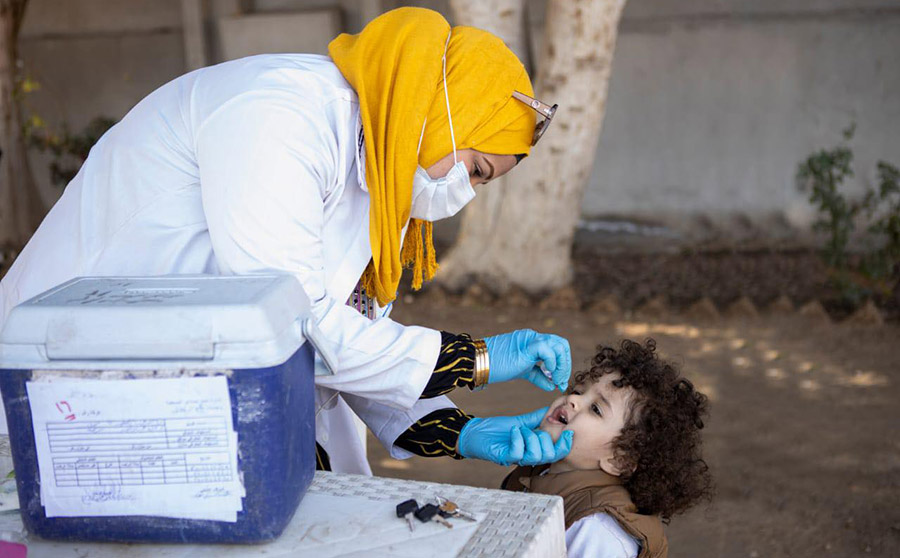 A child is vaccinated during the first round of polio response campaign in Egypt targeting 16.6 million children under age five in 2021
A child is vaccinated during the first round of polio response campaign in Egypt targeting 16.6 million children under age five in 2021
Egypt’s last confirmed case of wild poliovirus (WPV) was reported in 2004, and the country was declared polio-free in 2006. The earliest evidence of poliovirus comes from pharaonic illustrations in Egyptian artefacts from 3000 years ago, and since then the disease has paralysed millions of Egyptian children.
WPV was stamped out in Egypt through diligent efforts to immunize every child through seven doses within the routine immunization schedule, and additional doses through regular supplementary activity. But the 2021 outbreak of circulating vaccine-derived poliovirus type 2 (cVDPV2) has demonstrated that even countries with robust routine immunization programmes are vulnerable to polioviruses.
Responding to cVDPV2 transmission
In September 2020, an environmental sample taken from a collection site in Giza tested positive for vaccine-derived poliovirus type 2 (VDPV2). Since then, dozens of isolates from around the country have tested positive for VDPV2, suggesting ongoing transmission of VDPV2 in Egypt. As time goes by, the isolates captured show an increasing number of nucleotide changes, suggesting that the virus is passing through children’s bodies and mutating over time.
The lack of human cases of paralytic polio to date is a good thing: it tells us that the virus so far has only infected children with robust immunity, and/or that the virus circulating is not yet paralytic. But the course of action was clear for Egypt’s polio programme, which organized national immunization days to raise the immunity levels of all children in Egypt – both Egyptians and members of Egypt’s large and mobile migrant populations – in order to stop the virus before it encounters and paralyses an under-protected child.
In December 2021, Egypt was the first country in the Eastern Mediterranean Region to use novel oral polio vaccine type 2 (nOPV2), a next-generation version of the existing type 2 monovalent OPV (mOPV2). nOPV2 offers the same protection against polio infection and safety of use, but with a more stable genetic structure that makes it less likely to seed future outbreaks if high population immunity is not maintained.
In November 2020, nOPV2 became the first vaccine to be authorized under the WHO Emergency Use Listing. Since then, it has been administered over 100 million times and in October 2021 the Strategic Advisory Group of Experts on Immunization (SAGE) – an independent group of scientific experts who advise WHO on vaccines and immunization – endorsed the successful end of the initial use period for nOPV2.
Polio surveillance in Egypt
Egypt has a vast and well-functioning polio surveillance system, consisting of surveillance for acute flaccid paralysis (AFP) by health workers across the country, and environmental surveillance of sewage runoff.
Egypt consistently meets both of the international standards of polio surveillance, even during outbreak: the non-polio AFP rate is typically around three (the international standard is two or more) and the stool adequacy rate is usually in the high eighties (the international standard is 80%.
Environmental surveillance has been in place in Egypt since 2000 and workers are given regular training and refresher sessions. Forty-six collection sites operate across the country’s 27 provinces, with at least one in each province. Sites operate on the basis of monthly collection, but since the start of the 2021 outbreak, any site that collects a VDPV2 positive sample moves to a twice-monthly schedule.




